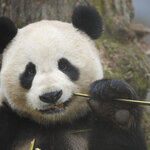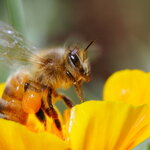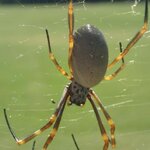Ecology & Zoology

Bamboo can also be a tasty snack. Credit: Chris Ison/PA
By Dirk Hebel, Swiss Federal Institute of Technology Zurich
Bamboo, a common grass which can be harder to pull apart than steel, has the potential to revolutionize building construction throughout the world. But that’s not all. As a raw material found predominantly in the developing world, without a pre-existing industrial infrastructure built to skew things towards the rich world, bamboo has the potential to completely shift international economic relations.
The past century has seen an unprecedented transfer of products and predefined…

Corals, whose calcium-carbonate skeletons form the foundation of coral reefs, are passive organisms that rely entirely on ocean currents to deliver dissolved substances, such as nutrients and oxygen.
Or so it seemed. Scientists at MIT and the Weizmann Institute of Science (WIS) in Israel have found that they are far from passive, engineering their environment to sweep water into turbulent patterns that greatly enhance their ability to exchange nutrients and dissolved gases with their environment.
It’s long been known that corals have cilia, small threadlike appendages that can push water…

The Brazilian Atlantic forest is home to animals, birds, plants, and tourist trains. Credit: EPA
By Cristina Banks-Leite, Imperial College London
Brazil’s Atlantic forest – Mata Atlântica – is one of the world’s great biodiversity hotspots, rivalling even the Amazon. Running on and off for several thousand kilometres along the coast, the forest is home to 10,000 plant species that don’t exist anywhere else, more bird species than the whole of Europe, and more than half of the country’s threatened animal species.
Today, the ecosystem it sustains is under threat: trees have been cleared for…

Honey bees play a vital role in pollination but their populations are under threat in many parts of the world. Flickr/Paul Stein, CC BY-SA
By Andrew Beattie
One of the biggest problems for conservation today is that it ignores 95% of all known species on Earth. Could a company ignore that proportion of its clients or a government so many of its voters? So why does this problem exist in conservation?
Some 90% of all of the Earth’s species are either invertebrates or micro-organisms, and the folly of ignoring the latter is encapsulated by UK Professor Tom Curtis writing in Nature Reviews…

Everyone's heard of the birds and the bees - why do they leave out the flowers that are being fertilized?
Maybe because it is too complicated. The fertilization process for flowering plants is particularly complex and requires extensive communication between the male and female reproductive cells. New research from an international team reports
in Nature Communications about discoveries in the chemical signaling process that guides flowering plant fertilization.
Flowering plants have a double fertilization system. Grains of pollen carry the male reproductive cells. When pollen grains…

A comprehensive study of rhino reproduction over six years encompassed 90% of the European population of captive black rhinos in Europe highlights and finds that hormone analysis could improve the success of breeding programs.
In total, 9,743 samples from 11 zoos were sent to Chester Zoo's Wildlife Endocrinology laboratory to analyze female reproductive cycles.
The first comprehensive study of captive black rhino reproduction highlights how hormone analysis could improve the success of breeding programs. Credit: Chester Zoo
Dr. Katie Edwards led the research as part of her PhD at…

By James Smith, Research Fellow in Fisheries at UNSW Australia
It may sound overly simple, but just five processes can define us as animals: eating, metabolism, reproduction, dispersal and death.
They might not seem like much, but, thanks to a mathematical model from scientists at Microsoft Research, we know that these five processes are the key to all ecosystems.
It’s called the Madingley Model, and is the first time scientists have simulated ecosystems across the globe using a single set of biological rules.
When these rules are combined with your body mass at birth and your body mass at…

When salmon encounter turbulent, fast-moving water, such as rapids or areas downstream of dams, they must move upstream using a behavior known as "burst swimming" that is similar to sprinting for humans.
Sockeye salmon that sprint to spawning grounds through fast-moving waters may be at greater risk, according to a new study. Previous research has found that burst swimming requires extra oxygen and energy, creates a build-up of stress metabolites like lactic acid in the blood, and may lead to cardiac collapse or heart attacks. A new study in Physiological and Biochemical Zoology shows that…

A common orb-weaving spider may grow larger and have an increased ability to reproduce when living in urban areas, according to ecologists from the University of Sydney.
They believe urbanization may drastically alter the landscape, local climate, and consequently the organisms that inhabit it. Some will no longer have the resources they need to survive in the urban environment, while others may thrive, possibly more so than in their native habitat; one way in which this may be evident is in marked changes in the organism's size.
The authors of this study investigated changes in the physical…
By Oliver Griffith, University of Sydney
Have you ever wondered why we give birth to live young rather than lay eggs? Scientists have pondered this for a long time and answers have come from an unlikely source: some of Australia’s lizards and snakes!
In research published this month in the American Naturalist, my colleagues and I at the University of Sydney studied reptile pregnancy to identify the factors necessary for a placenta to evolve.
Although most reptiles lay eggs, live birth has evolved many times in the group of reptiles that includes lizards and snakes.
Some of Australia’s most…